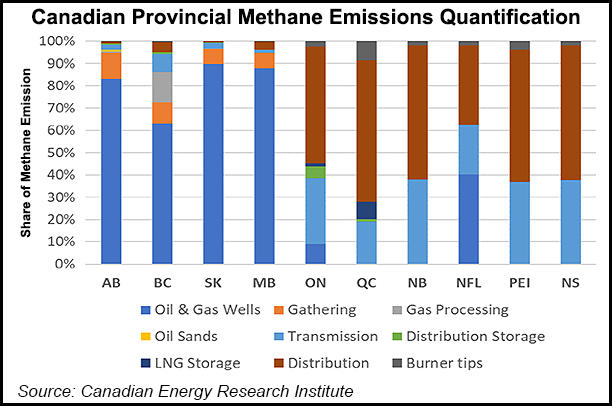E&P | NGI All News Access | NGI The Weekly Gas Market Report | Regulatory
Knowledge Gap Hampering Canada’s Efforts to Cut Methane Emissions, Report Says
Additional scientific detective work will be needed to help Canada’s federal government keep its promise to reduce methane emissions with regulations scheduled to go into force in 2020, predicts the C.D. Howe Institute.

Knowledge of the field remains sketchy, according to a review by the policy research agency. It added that incomplete leak measurement thwarts estimates of emissions and actions required to hit the national target of cutting them by 40-45%.
The Howe opinion echoes a February report by the Canadian Energy Research Institute (CERI) that projected costs of the methane policy but acknowledged the calculations rely on limited official government and industry information.
“There is a consensus about a knowledge gap in the amount of methane emitted from the natural gas supply chain,” CERI said.
Howe and CERI recite results of academic and consulting firm studies that suggest the official emissions catalogues underestimate true totals of methane leaks by 30% or more.
“Counting carbon dioxide emissions from a smokestack or tailpipe is relatively straightforward when compared to the methane escaping across an extensive, diffuse oil and gas supply chain,” Howe researchers said.
According to Howe, methane miscalculations result from a theoretical approach to deriving theoretical emission volumes that estimates leaks from examples of industrial equipment and counts, but does not observe, the hardware in practical use.
“In recent years, scientists across North American have shown that these inventories underestimate emissions by measuring emissions from the actual devices and facilities.”
The theoretical calculations are complicated and liable to change. Under a March revision of CERI’s February report, the initial forecast of methane emissions cleanup costs in Canada’s main gas- and oil-producer provinces was increased by C$289 million ($216 million) to C$1 billion ($750 million). The new figures include C$700 million ($525 million) in Alberta, C$134 million ($100 million) in British Columbia and C$180 million ($135 million) in Saskatchewan.
Nor are the revised estimates the last word. “More accurate data for [environmental and economic] modeling will become available over time as new field measurements are reported,” CERI said.
The Howe paper says a good start on taking observed methane emissions into account is being made by research collaboration between the Petroleum Technology Alliance Canada, the Canadian Association of Petroleum Producers, and the Explorers and Producers Association of Canada.
© 2024 Natural Gas Intelligence. All rights reserved.
ISSN © 2577-9877 | ISSN © 1532-1266 | ISSN © 2158-8023 |
